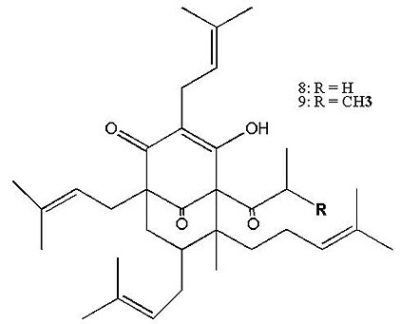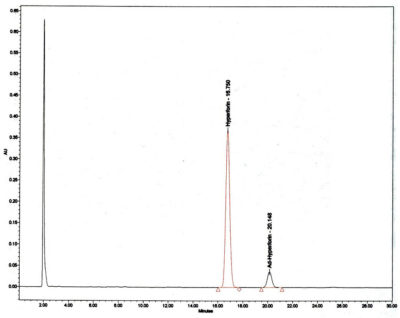The primary active constituent responsible for the antidepressant and anxiolytic properties of St. John′s Wort
- Catalog No: APH-20011
- CAS Number: 11079-53-1
- Chemical Formula: C35H52O4
- Molecular Weight: 536.80
- Purity: > 90% determined by HPLC; < 10 % Adhyperforin by HPLC
- Appearance: Slightly colored ethanolic solution
- Solubility: Soluble in methanol and ethanol
- Stability: Hyperforin is very unstable, decomposing rapidly in the presence of oxygen and light. It appears to be more stable in ethanol and methanol than as a solid.
- Storage: -20ºC
- Shipping: On ice (5ºC)
- Handling: Avoid exposure to oxygen and direct sunlight.
Source:
Hyperforin and adhyperforin are extracted from the flowers and buds of Hypericum perforatum (St. John’s Wort) utilizing patented SuperFluids™ CXP technology [Castor, US Patent]. Initial silica chromatography separates oils and polar components from hyperforin and adhyperforin. Then C18 chromatography is used to separate hyperforin and adhyperforin. Hyperforin is in greater quantity, and in the reversed phase system, hyperforin leads the adhyperforin. This means that the initial fractions will be hyperforin devoid of adhyperforin, and the later fractions will be adhyperforin contaminated with low levels of hyperforin.
Biological Activity:
Hyperforin is the primary active constituent responsible for the antidepressant and anxiolytic properties of extracts of St. John′s Wort.
Hyperforin acts as a reuptake inhibitor of serotonin and other monoamines including norepinephrine, dopamine, and GABA and glutamate by activating the transient receptor potential ion channel TRPC6. It also is an activator of the pregnane X receptor (PXR), which serves as a key regulator of CYP3A4 transcription, a member of the cytochrome (CYP) P450 enzyme system. Recent studies have found other neurological effects, effects on inflammation, as well as antibacterial, antitumoral and antiangiogenic effects.
References:
Beerhues L. (2006). Hyperforin. Phytochemistry. 67, 2201-2207.
Cantoni L, Rozio M, Mangolini A, Hauri L and Caccia S. (2003). Hyperforin Contributes to the Hepatic CYP3A-Inducing Effect of Hypericum perforatum Extract in the Mouse. Toxicological Sciences. 75, 25-30.
Cervo L, Rozio M, Ekalle-Soppo C, Guiso G, Morazzoni P and Caccia S. (2002). Role of hyperforin in the antidepressant-like activity of Hypericum perforatum extracts. Psychopharmacology. 164, 423-428.
Linde K, Ramirez G, Murlow C, Pauls A, Weidenhammer W and Melchart D. (1996). St John’s wort for depression—an overview and meta-analysis of randomized clinical trials. BMJ. Aug 3; 313(7052):253-258.
Woelk H. (2000). Comparison of St John’s wort and imipramine for treating depression: randomized controlled trials. BMJ. 321, 536-539.

